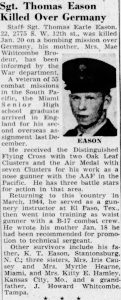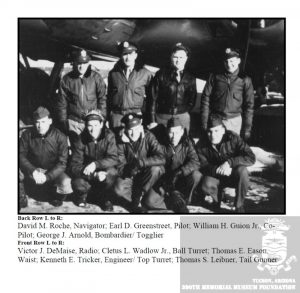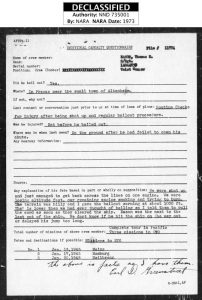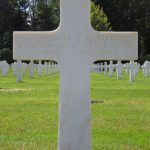Staff Sgt. Thomas E. Eason (1922 – January 20, 1945)
569th Bomber Squadron, 390th Bomber Group, Heavy
by John Lancaster
Even today, the horrors of World War II are difficult to truly understand. While recognizing that its battles were bloody and widespread, it can still be easy to forget that real men were behind the rifles and flight controls, and that every casualty number represents a real man who never came home. One such man was Staff Sergeant Thomas E. Eason, who died in eastern France on January 20, 1945, near the German border.1 Men like Eason, who lie in graves all over the world, were the men who fought the battles of World War II.
Early Life
Thomas E. Eason was born to Mabel Mae and Kinchen Thomas Eason in Florida in 1922.2 He had three sisters, Iris (1917), Myrtle (1920), and Kitty Mildred (1924).3 Kinchen was a commercial salesman for disinfectants. He was born in 1880 in North Carolina, while Mabel, maiden name Whitcombe, was born in 1894 in Florida. They likely met and married in Florida, where their first daughter, Iris, was born in 1917.4 By 1920, the family moved to Alabama, but returned to Florida a few years later and settled down in Miami.5
Kinchen and Mabel divorced in 1938, and while Kinchen returned to North Carolina, Mabel continued to raise Thomas and Kitty in Miami. Iris and Mytle were both married by this point, while Thomas and Kitty were still in high school and middle school, respectively. To support her family, Mabel worked as a cutter at an unnamed “clothing project.”6 Thomas Eason’s enlistment records indicate that he worked in the textile industry, so it is likely that he worked with her during or after high school.7 In July 1941, Mabel remarried to William H. Broder, and a month later Eason enlisted in the Army.8
Military Service
Eason served as a gunner for the Army Air Force. His first combat assignment was as a nose gunner in the South Pacific, where he participated in fifty-five combat missions and earned the Distinguished Flying Cross with Two Oak Leaf Clusters and an Air Medal with Seven Clusters for his service. In March 1944, the Army sent Eason to El Paso, Texas, to serve as a gunnery instructor.9 In December of the same year, they sent him overseas again to England for his second combat assignment, this time as a waist gunner for the 390th Bomber Group, 569th Bomber Squadron, on a B-17 nicknamed “Sweet and Lovely.”10
The Air Force activated the 390th on January 26, 1943, in Spokane, WA, and later moved its operations to Framlingham, England, in July of the same year. It was part of the Eighth Air Force, which, as part of the US’s heavy bombing force, carried out strategic bombings across the European Theater of World War II.11 The 390th twice acquired the Presidential Unit Citation, awarded for “extraordinary heroism in action against an armed enemy occurring on or after 7 December 1941.”12 It is no surprise they did, either—the 390th Bomber Group contributed to some of the most famous campaigns of the war. On June 6, 1944, they “bombed the coast near Caen fifteen minutes before the landings in Normandy,” and from December, 1944 through January, 1945, they helped “cut German supply lines during the Battle of the Bulge.”13 It is likely that Eason participated in the latter campaign.
In the January of 1945, the 569th Squadron, with Eason on board, flew from France into Germany on a mission to bomb the city of Heilbronn. There were nine men on the B-17 bomber, including Eason, on the day it flew into Heilbronn. Each of the men were required to fill out an ‘Individual Casualty Questionnaire’ after their mission. From these questionnaires, the story of Thomas Eason’s last flight forms.14
George J. Arnold, the bombardier on board, noted that enemy forces fired on the B-17 less than two minutes after entering the city, forcing the plane to leave formation “right before [it] hit the target—” the target being a bridge in east Heilbronn.15 Earl D. Greenstreet, the pilot of the plane, clarified:
“We were shot up and just managed to get back across the lines on one engine. We were losing altitude fast, our remaining engine smoking and trying to burn. The terrain was hilly and I gave the bailout warning at about 1000 feet. That was lower than we had ever thought of bailing so I told them to pull the cord as soon as they cleared the ship. Eason was the next to the last out of the ship…”16
Eason jumped at less than 1000 feet, but his parachute never deployed. He landed in a field somewhere near Altenheim, France, close to the German border. Greenstreet himself never bailed, instead piloting the plane until it crashed near the town of Steinburg, France.17 According to a combat chronology listing by the Eighth Air Force Historical Society, on January 20, 1945, 223 B-17 bombers were sent to Heilbronn. Two of the B-17s were lost, and one was damaged beyond repair. The plane Eason was on, which crashed behind Allied territory, was no doubt included in these statistics.18
According to combat records, the entire crew of “Sweet and Lovely” were considered missing in action (“MIA”) until January 28, 1945, which prompted a “Missing Air Crew Report,” filed shortly after the failed bombing. On January 28, rescue parties found the flight crew, and by February 16 they all returned to duty, with the exception of Thomas Eason. On the ‘Missing Air Crew Report’ mentioned above, someone edited the report to indicate that all the MIA crew members returned, except for Eason, whose “KIA” (Killed in Action) stands out near the bottom of the crew list.19
Legacy
Eason served four years in the United States Air Force—through the entirety of U.S. involvement during World War II. He enlisted as a private, eventually rising to the rank of staff sergeant by the time of his death. Surely, being in the army for so long, and aboard a B-17 with eight other men all the time, he had made close friends with those around him. In another ‘Individual Casualty Questionnaire,’ under the question, ‘Was he injured?’ the answer is handwritten— “Yes! He was killed.”20 The writer responded vehemently, exclamation point and all, and it is easy to grasp the ridiculousness he saw in this question—or perhaps it was the ridiculousness of the situation that got to him—but either way, Eason’s death prompted an emotional response, and one that is tangible even through paper.
1 “Headstone Inscription and Internment Record,” database, Fold3.com (www.fold3.com: accessed March 31, 2021), entry for Thomas E. Eason.
2 “1940 U.S. Census,” database, Ancestry.com (www.ancestry.com: accessed March 31, 2021), entry for Mae Whitecombe; “WWII Army Enlistment Records,” database, Fold3 (www.fold3.com: accessed March 31, 2021), entry for Thomas E. Eason.
3 “1920 U.S. Census,” database, Ancestry.com (www.ancestry.com: accessed March 31, 2021), entry for Kinchen Eason; “1940 U.S. Census;” “Florida, U.S., Marriage Idexes, 1822-1875 and 1927-2001, database, Ancestry.com (www.ancestry.com: accessed March 31, 2021), entry for Myrtle W. Eason.
4 “1920 U.S. Census.”
5 “U.S., City Directories, 1822-1995,” database, Ancestry.com (www.ancestry.com: accessed March 31, 2021), entry for Kinchen T. Eason, Miami, Florida, 1924.
6 “Florida, U.S., Divorce Index, 1927-2001,” database, Ancestry.com (www.ancestry.com: accessed March 31, 2021), entry for Kinchen Thos and Mabel Mae Eason; “1940 U.S. Census.”
7 “WWII Army Enlistment Record.”
8 “Florida, U.S., Country Marriage, 1823-1982,” database, Ancestry.com (www.ancestry.com: accessed March 31, 2021), entry for Mae Whitcombe and William H. Broder.
9 “Sgt. Thomas Eason Killed Over Germany,” unknown newspaper, Find a Grave, accessed March 31, 2021, https://www.findagrave.com/memorial/56372149/thomas-e-eason, article posted by Jaap Vermeer on November 16, 2020.
10 “Sgt. Thomas Eason Killed;” “Headstone Inscription and Internment Record.”
11 “390th Bombardment Group – 8th AFHS,” Eighth Air Force Historical Society, accessed October 20, 2016, https://8thafhs.org/bomber/390bg.htm.
12 “Distinguished Unit Citations – OPHSA,” The Outpost Harry Survivors Association, accessed October 20, 2016, http://www.ophsa.org/DUC/.
13 “390th Bombardment Group – 8th AFHS.”
14 “Missing Air Crew Reports of the United States Armed Forces, 1942-1947,” database, Fold3 (https://www.fold3.com/image/46705948: accessed October 10, 2016), entry for aircraft serial number 44-8151.
15 “Missing Air Crew Reports,” page 7. See image at the RICHES Epinal American Cemetery Collection here.
16 “Missing Air Crew Reports, page 9. See image at the RICHES Epinal American Cemetery Collection.
17 Ibid.
18 “390th Bombardment Group – 8th AFHS.”
19 “Missing Air Crew Reports,” page 2. See image at the RICHES Epinal American Cemetery Collection.
20 “Missing Air Crew Reports,” page 6. See image at the RICHES Epinal American Cemetery Collection here.



